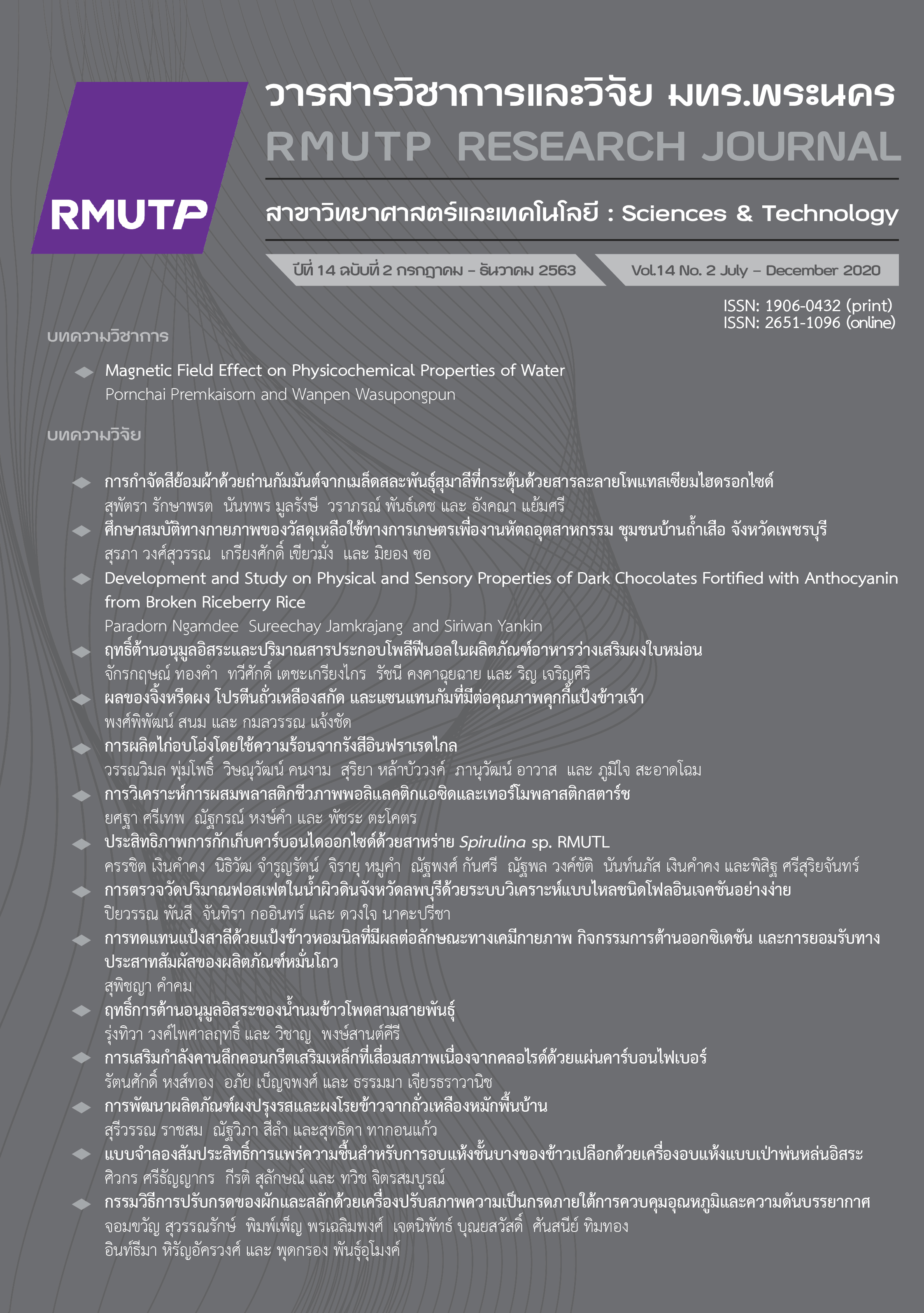ผลของจิ้งหรีดผง โปรตีนถั่วเหลืองสกัด และแซนแทนกัมที่มีต่อคุณภาพคุกกี้แป้งข้าวเจ้า
Main Article Content
บทคัดย่อ
คุกกี้จากแป้งข้าวเจ้าเป็นผลิตภัณฑ์ขนมอบปราศจากกลูเตน จิ้งหรีดผงและโปรตีนถั่วเหลืองสกัดเป็นแหล่งของโปรตีนทางเลือกที่ให้คุณค่าทางโภชนาการ แซนแทนกัมเป็นไฮโดรคอลลอยด์ชนิดหนึ่งที่มีผลต่อเนื้อสัมผัสของคุกกี้ งานวิจัยนี้จึงได้ศึกษาผลของจิ้งหรีดผง โปรตีนถั่วเหลืองสกัด และแซนแทนกัมต่อคุณภาพทางกายภาพ เคมี และประสาทสัมผัสของคุกกี้แป้งข้าวเจ้า จากศึกษาการแทนที่แป้งข้าวเจ้าด้วยแหล่งโปรตีน 2 ชนิด คือจิ้งหรีดผงร้อยละ 25 และ 35 ร่วมกับโปรตีนถั่วเหลืองสกัดร้อยละ 0, 25 และ 35 ที่มีต่อคุณภาพของผลิตภัณฑ์ โดยการจัดสิ่งทดลองแบบแฟคทอเรียล (2x3) ในแผนการทดลองสุ่มสมบูรณ์ พบว่าเมื่อเพิ่มปริมาณจิ้งหรีดผง หรือลดปริมาณโปรตีนถั่วเหลืองสกัด ส่งผลให้ขนาดเส้นผ่านศูนย์กลางของผลิตภัณฑ์เพิ่มขึ้น แต่ค่าความแข็งลดลงอย่างมีนัยสำคัญทางสถิติ (p≤0.05) การศึกษาผลของปริมาณแซนแทนกัมที่ร้อยละ 0, 0.14, 0.28 และ 0.42 ต่อคุณภาพผลิตภัณฑ์ พบว่าเมื่อปริมาณแซนแทนกัมเพิ่มขึ้น ส่งผลให้ค่าวอเตอร์แอคทิวิตี้ ความชื้น และความแข็งของผลิตภัณฑ์เพิ่มขึ้นอย่างมีนัยสำคัญทางสถิติ (p≤0.05) ขณะที่คะแนนความชอบด้านความแข็ง และความชอบโดยรวมมีค่าลดลงอย่างมีนัยสำคัญทางสถิติ (p≤0.05) ดังนั้นสูตรที่เหมาะสมของคุกกี้แป้งข้าวเจ้า คือ ทดแทนแป้งข้าวเจ้าด้วยจิ้งหรีดผงร้อยละ 25 โปรตีนถั่วเหลืองสกัดร้อยละ 35 และไม่ใส่แซนแทนกัม
Article Details
References
T. Duangruthai, J. Wipawan and W. Rungtiwa, Bread and gluten-free bakery, 1st ed. Bangkok: Petchprakai Publishers, 2017.
N. Nammakuna, S. Suwansri, P. Thanasukan and P. Ratanatriwong “Effects of hydrocolloids on quality of rice crackers made with mixed-flour blend,” Asian Journal of Food and Agro-Industry, vol. 2, no. 4, pp. 780–787, 2009.
A. Torbica, M. Hadnađev and T. D. Hadnađev, “Rice and buckwheat flour characterisation and its relation to cookie quality,” Food Research International, vol. 48, no. 1, pp. 277–283, 2012.
World Health Organization, Food and Agriculture Organization of the United Nations and United Nations University, Protein and Amino Acid Requirements in Human Nutrition, 1st ed. Geneva: WHO Press, pp. 79–89, 2007.
L. Yi, C. M. M. Lakemond, L. M. C. Sagis, V. Einner-Schadler, A. van Huis and M. A. J. S. van Boekel, “Extraction and characterisation of protein fractions from five insect species,” Food Chemistry, vol. 141, pp. 3341–3348, 2013.
Global New Products Database. (2018, November 30). Cricket [Online]. Available: http://www.gnpd.com/database/cricket.
A. Osimani, V. Milanovic, F. Cardinali, A. Roncolini, C. Garofalo, F. Clementi, M. Pasquini, M. Mozzon, R. Foligni, N. Raffaelli, F. Zamporlini and L. Aquilanti, “Bread enriched with cricket powder (Acheta domesticus): A technological microbiological and nutritional evaluation,” Innovative Food Science and Emerging Technologies, vol. 48, pp. 150–163, 2018.
P. Pauter, M. Rózanska, P. Wiza, S. Dworczak, N. Grobelna, P. Sarbak and P. L. Kowalczewski, “Effects of the replacement of wheat flour with cricket powder on the characteristics of muffins,” Acta Scientiarum Polonorum Technologia Alimentaria, vol. 17, no. 3, pp. 227–233, 2018.
C. da Rosa Machado and R. C. S. Thys, “Cricket powder (Gryllus assimilis) as a new alternative protein source for gluten-free breads,” Innovative Food Science and Emerging Technologies, vol. 56, pp. 102180, 2019.
P. Singh, R. Kumar, S. N. Sabapathy and A. S. Bawa, “Functional and edible uses of soy protein products,” Comprehensive Reviews in Food Science and Food Safety, vol. 7, pp. 14–28, 2008.
M. Sugano, Soy in Health and Disease Prevention, 1st ed. New York: CRC Press Publishers, 2006.
A. Nussinovitch, Hydrocolloid Applications: Gum technology in food and the other industries, 1st ed. London: Blackie Academic & Professional Publishers, 1997.
C. M. Rosell and R. Garzon, Food Microstructure and Its Relationship with Quality and Stability, 1st ed. Duxford: Woodhead Publishing, 2018.
L. D. Preichardt, C. T. Vendruscolo, M. A. Gularte and A. S. Moreira, “The role of xanthan gum in the quality of gluten free cakes: improved bakery products for coeliac patients,” International Journal of Food Science and Technology, vol. 46, pp. 2591–2597, 2011.
C. R. Encina-Zelada, V. Cadavez, F. Monteiro, J. A. Teixeira and U. Gonzales-Barron, “Combined effect of xanthan gum and water content on physicochemical and textural properties of gluten-free batter and bread,” Food Research International, vol. 111, pp. 544–555, 2018.
S. Benkadri, A. Salvador, M. N. Zidoune and T. Sanz, “Gluten-free biscuits based on composite rice-chickpea flour and xanthan gum,” Food Science and Technology International, vol. 24, no. 7, pp. 607–616, 2018.
Association of Official Analytical Chemists, Official Methods of Analysis, 19th ed. Maryland: AOAC International Publishers, 2012.
A. G. Roberts, Gluten-free baking classics, 2nd ed. Chicago: Surrey Books Publishers, 2008.
S. G. F. Bukkens, “Insect in the human diet: nutrition aspects,” in Ecological Implications of Minilivestock: Potential of Insect, Rodents, Frogs and Snails, M. G. Paoletti, ed., New Hampshire: Science Publishers, 2005, pp. 545–577.
J. C. Ribeiro, R. C. Lima, M. R. G. Maia, A. A. Almeida, A. J. M. Fonseca, A. R. J. Cabrita and L. M. Cunha, “Impact of defatting freeze-dried edible crickets (Acheta domesticus and Gryllodes sigillatus) on the nutritive value, overall liking and sensory profile of cereal bars,” LWT- Food Science and Technology, vol. 113, pp. 1–7, 2019.
S. A. O. Adeyeye, A. O. Adebayo-Oyetoro and S. A. Omoniyi, “Quality and sensory properties of maize flour cookies enriched with soy protein isolate,” Cogent Food and Agriculture, vol. 3, pp. 1–11, 2017.
C. M. Rosell, J. A. Rojas and C. B. de Barber, “Influence of hydrocolloids on dough rheology and bread quality,” Food Hydrocolloids, vol. 15, pp. 75–81, 2001.
R. Devisetti, R. Ravi and S. Bhattacharya, “Effect of Hydrocolloids on Quality of Proso Millet Cookie,” Food and Bioprocess Technology, vol. 11, pp. 2298–2308, 2015.
Nutrition labeling, Notification of the Ministry of Public Health 182, 1998.

